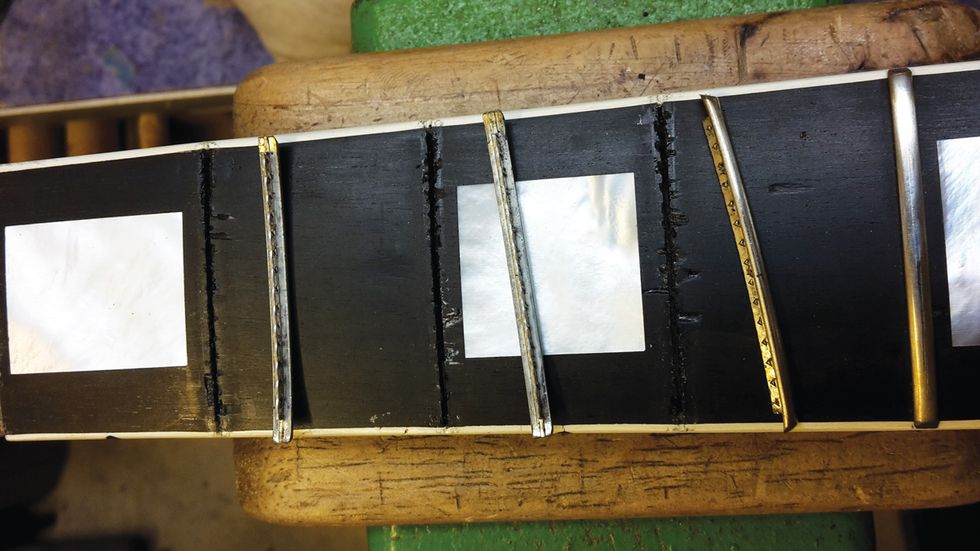It can be entertaining for both players and luthiers to swap guitar-repair horror stories, because so many things can go wrong. One head-scratcher concerns a “guitar tech” who, for whatever reason, didn’t want to tackle refretting an instrument, so he instead filed away the fretboard between the worn frets. If that were my guitar, I’d be extremely upset!
Most horror stories involve money, missed delivery dates, or bad etiquette, but some reveal a lack of knowledge by the person who attempted the repair. Every shop owner or tech has a tale of a customer who brought in an instrument that was butchered by either its owner or another musician pal.
Today, we have almost unlimited access to guides and repair suggestions, so if one of our axes isn’t working properly, it’s tempting to seek immediate help. Unfortunately, some information out there is of dubious value. Many jobs require a basic understanding of the underlying technology or require at least some prior experience. And to have a positive outcome, every job demands the right tools and the ability to use them properly.
Sometimes testing your newly acquired soldering skills on your beloved instrument isn’t a good idea. Cleaning up a botched soldering mess or fixing an overly enthusiastic fret removal gnaws at the nerves of every pro, and righting a job gone wrong can ultimately cost you more than if you’d hired a qualified luthier to begin with. Knowing where to draw the line can save you money and embarrassment.
Take, for example, Photo 1. According to the owner, 13 of his friends tried to repair this instrument, but what they accomplished looks like the result of a severe fire. Note that this photo was taken after removing a grape-sized bubble of solder, which covered the circuit board and destroyed it in the process.
If you take the time to learn the basics, modding or fixing your instrument can be fun and rewarding, and a lot of this knowledge is available from Premier Guitar. But whatever your source, you need to approach guitar repair with realistic expectations and an honest appraisal of your skills. If you don’t know how to do a proper setup—and haven’t done dozens of them—don’t kid yourself: You shouldn’t try to refret a guitar. Photo 2 shows a fretboard that experienced a previous home-fretting job. Or it might have been the work of a bad guitar tech—it’s often hard to distinguish one from the other. Either way, someone had to clean up this mess.
Image 2
Soldering and fretting are not the only jobs where an initial failure will impede completing the task successfully. When you try to re-attach a broken headstock with household glues, this can hinder any subsequent professional repairs. Your glue will not be strong enough to hold the headstock in place, yet it will prove surprisingly tenacious and withstand any efforts to completely remove the crap.
The stories pros share about home-brew repairs gone wrong or what it takes to undo the work of unqualified guitar techs sometimes result in humorous exchanges. For instance, here’s a translation of a price list said to be circulating among Spanish luthiers:
• Price per hour of work: $50
Exceptions:
• If you want to attend: $60
• If you give your opinion: $75
• If you help: $85
• If you and a friend have tried to do it before: $95
• If you and a friend have tried to do it before and you haven’t revealed this: $125
• If you’ve seen it on the internet and it seemed easy: $150
Feel free to share your own horror story or amusing tale from either side of the workbench in the comment section below. Who knows? You might spare someone some grief down the road.









![Rig Rundown: AFI [2025]](https://www.premierguitar.com/media-library/youtube.jpg?id=62064741&width=1245&height=700&quality=70&coordinates=0%2C0%2C0%2C0)












 Shop Scott's Rig
Shop Scott's Rig
![Rig Rundown: Russian Circles’ Mike Sullivan [2025]](https://www.premierguitar.com/media-library/youtube.jpg?id=62303631&width=1245&height=700&quality=70&coordinates=0%2C0%2C0%2C0)














































